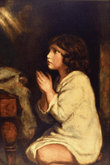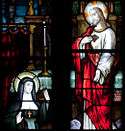Eucharistic adoration
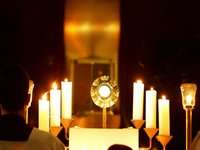
| Part of a series on the |
| Eucharist Lord's Supper • Communion |
|---|
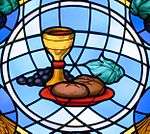 |
| Elements |
| Ritual and liturgy |
| Practices and customs |
|
| History |
| Theology |
| Denominational teachings |
| Related articles |
| Part of a series on |
| Eucharistic adoration of the Catholic Church |
|---|
 Solar monstrance of the Eucharist. |
| Papal documents |
| Organisations and events |
| Notable individuals |
| Eucharistic meditators |
|
|
Eucharistic adoration is a practice in the Roman Catholic, Anglo-Catholic and some Lutheran traditions, in which the Blessed Sacrament is exposed and adored by the faithful.[1][2]
Adoration is a sign of devotion to and worship of Jesus Christ, who is believed by Catholics to be present Body, Blood, Soul, and Divinity, under the appearance of the consecrated host, in the form of hosts, that is, consecrated altar bread. As a devotion, Eucharistic adoration, prayer, and meditation are more than merely looking at the Blessed Host, but are believed to be a continuation of what was celebrated in the Eucharist.[3] From a theological perspective, the adoration is a form of latria, based on the tenet of the real presence of Christ in the Blessed Host.[4][5]
Christian meditation performed in the presence of the Eucharist outside of Mass is called Eucharistic meditation. It has been practiced by such as Peter Julian Eymard, Jean Vianney and Thérèse of Lisieux.[6][7][8][9][10] Authors such as the Venerable Concepcion Cabrera de Armida and Blessed Maria Candida of the Eucharist have produced large volumes of text based on their Eucharistic meditations.[11][12][13]
When the exposure and adoration of the Eucharist is constant (twenty-four hours a day), it is called Perpetual adoration. In a monastery or convent, it is done by the resident monks or nuns and, in a parish, by volunteer parishioners since the 20th century.[14] In the opening prayer of the Perpetual chapel in St. Peter Basilica, Pope John Paul II prayed for a perpetual adoration chapel in every parish in the world.[15] Pope Benedict XVI instituted perpetual adoration for the laity in each of the five sectors of the diocese of Rome.[16]
Practice and context
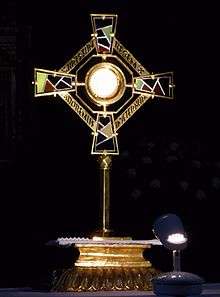
Eucharistic adoration may be performed both when the Eucharist is exposed for viewing and when it is not.[17] In Exposition of the Blessed Sacrament, the Eucharist is displayed in a monstrance, typically placed on an altar, at times with a light focused on it, or with candles flanking it. The exposition usually occurs in the context of a service of Benediction or similar service of devotions to the Blessed Sacrament.[1][2][18] Exposition also takes place in the context of "perpetual adoration", where specific people attend the exposition for a certain period of time, 24 hours a day.[18]
The adoration may also take place when the Eucharist is not exposed but left in a ciborium, which is likewise placed on an altar or in an enclosed tabernacle so that the faithful may pray in its presence without the need for volunteers to be in constant attendance (as is required when the Blessed Sacrament is exposed).[2][19]
Official Catholic teachings consider the exposition and adoration of the Blessed Sacrament an important practice which "stimulates the faithful to an awareness of the marvelous presence of Christ and is an invitation to spiritual communion with Him."[18][20]
In many cases Eucharistic adoration is performed by each person for an uninterrupted hour known as the Holy Hour.[21] The inspiration for the Holy Hour is Matthew 26:40 when in the Garden of Gethsemane the night before his crucifixion, Jesus asks Peter: "So, could you men not keep watch with me for one hour?".[22]
While psalms, readings and devotional music may be performed during Eucharistic adoration, in many Roman Catholic churches this is rarely done and silent contemplation and reflection is the focus of adoration.[17] Pope John Paul II would spend many hours in silent Eucharistic adoration and stated that the practice provides contact with the "very wellspring of grace".[23][24]
Since the Protestant Reformation, some Christian denominations have criticized Eucharistic adoration, even considering it a form of idolatry.[25][26] Many Anglicans, Catholics and Lutherans contend that it cannot be idolatry because Christ, whole and entire, is present in the Eucharist.
History
Early history
While the keeping of the Blessed Sacrament outside of Mass seems to have been part of the Eucharistic Christian practice from the beginning, (both Justin Martyr and Tertullian refer to it), the practice of adoration began somewhat later.[19]
One of the first possible references to reserving the Blessed Sacrament for adoration is found in a life of St. Basil (died AD 379). Basil is said to have divided the Eucharistic bread into three parts when he celebrated the Divine Liturgy in the monastery. One part he consumed, the second part he gave to the monks, and the third he placed in a golden dove-shaped container suspended over the altar.[27] It is more likely, however, that this separate portion was simply for the purpose of reserving the sacrament for distribution in contexts in which a communicant could not attend the liturgy, which is a standard practice throughout the ancient churches, even those which do not practice extra-liturgical Eucharistic adoration.
In Eastern Christianity, the sort of extra-liturgical adoration which developed in the West has never been part of the Eastern liturgy which St. Basil celebrated, but a liturgy for adoration does exist among the Eastern Catholic Churches, involving psalms and placing a covered diskos with the sacred species on the altar. This is befitting the Eastern custom of veiling those things deemed sacred from human eyes.[28]
Middle Ages
The Franciscan archives credit Saint Francis of Assisi (who died in 1226) for starting Eucharistic Adoration in Italy. This process then spread from Umbria to other parts of Italy by the Franciscans.[29][30] Francis had a deep devotion to the Eucharist and Saint Bonaventure commented that Francis would be swept in ecstasy after receiving Communion. For Francis, the adoration of the Eucharist amounted to "seeing Christ".[31]
The theological basis for the adoration was prepared in the 11th century by Pope Gregory VII, who was instrumental in affirming the tenet that Christ is present in the Blessed Host. In 1965, the confession of belief that Gregory imposed on Berengarius was quoted in Pope Paul VI's historic encyclical Mysterium fidei:[32]
"I believe in my heart and openly profess that the bread and wine that are placed on the altar are, through the mystery of the sacred prayer and the words of the Redeemer, substantially changed into the true and proper and lifegiving flesh and blood of Jesus Christ our Lord, and that after the consecration they are the true body of Christ"[33]
This profession of faith began a "Eucharistic Renaissance" in the churches of Europe.[34] As of the fourteenth century in The Western Church, devotions began to focus on the Eucharistic gifts as the objective presence of the risen Christ and the Host began to be elevated during the liturgy for the purpose of adoration.[35]
The lay practice of adoration formally began in Avignon, France on September 11, 1226. To celebrate and give thanks for the victory over the Albigensians in the later battles of the Albigensian Crusade, King Louis VIII asked that the sacrament be placed on display at the Chapel of the Holy Cross.[36] The overwhelming number of adorers brought the local bishop, Pierre de Corbie, to suggest that the exposition be continued indefinitely. With the permission of Pope Honorius III, the idea was ratified and the adoration continued there practically uninterrupted until the chaos of the French Revolution halted it from 1792.
In the thirteenth century, the Feast of Corpus Christi was instituted. From this point, devotion to the Blessed Sacrament, both within and outside the Mass, became central in the piety of Western Christians.
16th–18th centuries
In the 16th century, the Protestant Reformation was challenging various issues with respect to the Eucharist and the Council of Trent responded to them via specific affirmations of the presence of Christ in the Eucharist and the theological basis for Eucharistic adoration. The Trent declaration was of the most significant theological component of Eucharistic doctrine since the apostolic age.[37] The statement included the following:
The other sacraments do not have the power of sanctifying until someone makes use of them, but in the Eucharist the very Author of sanctity is present before the Sacrament is used. For before the apostles received the Eucharist from the hands of our Lord, He told them that it was His Body that He was giving them.[37]
The council then declared Eucharistic adoration as a form of latria:
The only-begotten Son of God is to be adored in the Holy Sacrament of the Eucharist with the worship of "latria", including external worship. The Sacrament, therefore, is to be honored with extraordinary festive celebrations (and) solemnly carried from place to place in processions according to the praiseworthy universal rite and custom of the holy Church. The Sacrament is to be publicly exposed for the people's adoration.[4]
Following the Council of Trent, figures such as Saints Charles Borromeo and Alain de Solminihac promoted Eucharistic devotion and adoration.[38] As part of the simplification of Church interiors, and to emphasize the importance of the Blessed Sacrament, Charles Borromeo initiated the practice of placing the tabernacle at a higher, central location in the main altar. As Eucharistic adoration and Benediction became more widespread during the 17th century, the altar came to be seen as the "home of the Blessed Sacrament" where it would be adored.[39]
A common early practice of adoration known as Quarantore (literary forty hours) started in the 16th century. It is an exercise of devotion in which continuous prayer is made for forty hours before the exposed Blessed Sacrament. This practice started in Milan in the 1530s and 1540s by Capuchins such as Giuseppe da Fermo who promoted long periods of adoration. From Northern Italy it was carried to elsewhere in Europe by the Capuchins and Jesuits.[40][41]
The practice of the perpetual adoration of the Blessed Sacrament started in Paris on March 25, 1654 in the Benedictine society formed for that purpose by Mother Mechtilde of the Blessed Sacrament.[42]
In the 18th century, large numbers of people were drawn to quiet adoration of the Eucharist and priests such as Alphonsus Liguori encouraged the practice.[43] He wrote a book on Visits to the Blessed Sacrament and he explained that a visit to the Blessed Sacrament is the "practice of loving Jesus Christ", since friends who love each other visit regularly. A model for the love of Eucharist at this time in Rome was Saint Benedict Joseph Labre, a homeless beggar and Franciscan tertiary, who spent many hours wrapped in silent ecstasy as he adored the Blessed Sacrament, at times in the sacrament-chapel of St. Peter's Basilica, and became known as the "saint of the Forty Hours".[43]
19th and 20th centuries
During the French Revolution, the persecution of Catholics hindered the practice of Eucharistic adoration. However, the beginning of the 19th century witnessed a strong emphasis on Eucharistic piety, devotions and adorations. It may be said that at the beginning of the 19th century no Catholic saint can be found who did not place Eucharistic piety at the center of their spirituality.[43]
By 1829, the efforts of the Confraternity of Penitents-Gris brought Eucharistic adoration back in France.[44] Twenty years later, the Venerable Leo Dupont initiated the nightly adoration of the Blessed Sacrament in Tours in 1849, from where it spread within France.[45] Saint Anthony Mary Claret, the confessor to Isabella II of Spain and the founder of the Claretians, was also a fervent promoter of Eucharistic devotion and adoration and introduced the practice to Cuba, where he was sent as Archbishop.[46]

The adoration of the Eucharist within France grew in this period and there were interactions between Catholic figures who were enthusiastic about spreading the Eucharist e.g., Leo Dupont, Saint Jean Vianney and Saint Peter Julian Eymard, who in 1858, formed the Congregation of the Blessed Sacrament.[47]
Also in 1858, Eymard, known as the Apostle of the Eucharist, and sister Marguerite Guillot formed the Servants of the Blessed Sacrament which now maintains houses on several continents where continuous Eucharistic adoration takes place.[48]
The first informally organized Eucharistic Congress took place in 1874, through the efforts of Marie-MartheTamisier of Tours, France.[49] In 1881 Pope Leo XIII approved the first formal Eucharistic Congress which was organized by Louis-Gaston de Ségur in Lille France and was attended by few adherents.[50] The 1905 congress took place in Rome and Pope Pius X presided over it.[49]
The practice of prolonged Eucharistic adoration also spread to the United States in the 19th century and Saint John Neumann the Archbishop of Philadelphia started Forty Hours adorations there, where it continues to date.[51]
Christian traditions
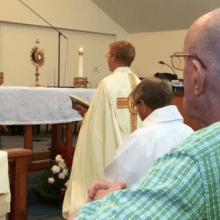
Anglicans and Methodists
Early Anglicanism, followed by the Methodist movement, both officially rejected Eucharistic adoration. Article XXVIII — Of the Lord's Supper in Anglicanism's 39 Articles and Article XVIII — Of the Lord's Supper in Methodism's Articles of Religion deny transubstantiation, declaring that "Transubstantiation (or the change of the substance of Bread and Wine) in the Supper of the Lord, cannot be proved by Holy Writ; but is repugnant to the plain words of Scripture, overthroweth the nature of a Sacrament, and hath given occasion to many superstitions."[52][53] Both Articles also state that "The Sacrament of the Lord's Supper was not by Christ's ordinance reserved, carried about, lifted up, or worshiped."[54][55] Furthermore, the Black Rubric (in both its 1552 and 1662 versions) explain that "the Sacramental Bread and Wine remain still in their very natural substances, and therefore may not be adored; for that were Idolatry, to be abhorred of all faithful Christians".
However, since the mid-19th century, the Oxford Movement has broadened Anglican opinions on the matter. For example, an early 20th century bishop, the Right Reverend Edgar Gibson, Bishop of Gloucester, wrote of Article 28 that "The statement in the Article is worded with the utmost care, and with studied moderation. It cannot be said that any one of the practices is condemned or prohibited by it. It only amounts to this: that none of them can claim to be part of the original Divine institution."[56]
Today, opinions on the nature of the Eucharist and thus on the propriety of adoration and exposition of the Blessed Sacrament vary in the Anglican tradition (see Anglican Eucharistic theology), but many Anglo Catholics practice Eucharistic adoration. Others celebrate Benediction of the Blessed Sacrament, which is not unlike Eucharistic adoration.[57]
Lutherans
.jpg)
Lutheran Eucharistic adoration is most commonly limited in duration to the Eucharistic service because Lutheran tradition typically does not include public reservation of the Sacrament. If the holy elements are not consumed at the altar or after the service, then they can be set aside and placed in an aumbry, which is normally located in the sacristy. Primarily, the extra hosts are reserved for another Eucharist or for taking to the sick and those too feeble to attend a church service. However, in North America and Europe, some Lutherans may choose to reserve the Eucharist in a tabernacle near the altar. The Anglo-Lutheran Catholic Church and some parishes in the Lutheran Evangelical Catholic tradition strongly encourage Eucharistic adoration.
Historically in Lutheranism there have been two parties regarding Eucharistic adoration: Gnesio-Lutherans, who followed Martin Luther's view in favor of adoration, and Philippists who followed Philipp Melanchthon's view against it. Although Luther did not entirely approve of the Feast of Corpus Christi,[58] he wrote a treatise "The Adoration of the Sacrament" (Von anbeten des sakraments des heyligen leychnahms Christi, 1523) where he defended adoration but desired that the issue not be forced. In his reform of the Roman Mass Luther placed the Sanctus after the Institution Narrative to serve as a solemn act of worship of the Real Presence just brought about by the latter. After the death of Martin Luther, further controversies developed including Crypto-Calvinism and the second Sacramentarian controversy, started by Gnesio-Lutheran Joachim Westphal. The Philippist understanding of the Real Presence without overt adoration through time became dominant in Lutheranism, although it is not in accordance with Luther's teaching. The German theologian Andreas Musculus can be regarded as one of the warmest defenders of Eucharistic adoration in early Lutheranism.[59]
Roman Catholics
In Catholic teachings, at the moment of Consecration the elements (or "gifts" as they are termed for liturgical purposes) are changed in substance (Transubstantiation – as opposed to 'transformation' wherein a change in physical form occurs) into the actual Body and Blood of Christ. Catholic doctrine holds that the elements are not only spiritually changed, but rather, their substances are actually (substantially) changed into the Body, Blood, Soul and Divinity of Christ. In the doctrine of Real Presence, at the point of Consecration, the act that takes place is a double miracle: 1) that Christ is present in a physical form and 2) that the bread and wine have truly, substantially become Jesus' Body and Blood. Because Roman Catholics believe that Christ is truly present (Body, Blood, Soul and Divinity) in the Eucharist, the reserved sacrament serves as a focal point of adoration. The Catechism of the Catholic Church (item 1377) states that: "The Eucharistic presence of Christ begins at the moment of the consecration and endures as long as the Eucharistic species subsist."[60][61] The official Raccolta book provides specific indulgences for Eucharistic adoration during the Exposition of the Blessed Sacrament.[21]
Prolonged Eucharistic adoration is one of the distinguishing features of Roman Catholicism and is credited with the calling of saints and the bringing of converts to the Catholic Church. St. Faustina Kowalska stated that she was called to religious service while attending the Exposition of the Blessed Sacrament at age seven.[62] Notable examples of conversion are Saints Elizabeth Ann Seton and John Henry Newman, both having converted from Anglicanism,[43] and the Venerable Hermann Cohen (Carmelite), O.C.D., from Judaism, following Eucharistic adoration. Cohen went on to help establish the widespread practice of nocturnal adoration.
The practice of a "daily Holy Hour" of adoration has been encouraged in the Catholic tradition, for instance Mother Teresa of Calcutta had a Holy Hour each day and all members of her Missionaries of Charity followed her example.[63][64]
Since the Middle Ages the practice of Eucharistic adoration outside Mass has been encouraged by the popes.[65]
In the middle of the Second Vatican Council, on September 3, 1965, a few days before opening the fourth session, Pope Paul VI issued the Encyclical Mysterium fidei whereby he urged daily Mass and communion and said that "In the course of the day the faithful should not omit to visit the Blessed Sacrament, which according to the liturgical laws must be kept in the churches with great reverence in a most honorable location. Such visits are a proof of gratitude, an expression of love, an acknowledgment of the Lord's presence." "The daily adoration or visit to the Blessed Sacrament is the practice which is the fountainhead of all devotional works," St. Pius X used to say.
In Dominicae Cenae Pope John Paul II stated:
The Church and the world have a great need of Eucharistic worship. Jesus waits for us in this sacrament of love. Let us be generous with our time in going to meet Him in adoration and in contemplation that is full of faith.[66]
And in Ecclesia de Eucharistia John Paul II stated:
The worship of the Eucharist outside of the Mass is of inestimable value for the life of the Church.... It is the responsibility of Pastors to encourage, also by their personal witness, the practice of Eucharistic adoration, and exposition of the Blessed Sacrament.[67]
From his early years, the Eucharist had a central place in the theology of Joseph Ratzinger and in his role as Pope Benedict XVI as well as in his book God Is Near Us: The Eucharist, the Heart of Life he strongly encouraged Eucharistic adoration.[68][69]
Catholic prayers to the Blessed Sacrament

The Handbook of Prayers by Fr. Charles Belmonte and James Socias said that a simple way of doing the visit to the Blessed Sacrament is to pray 3 Our Fathers, 3 Hail Marys and 3 Glory Bes, and ended with a Spiritual Communion, as for example, "I wish, Lord, to receive You with the purity, humility and devotion, with which Your Most Holy Mother received You, with the spirit and fervor of the saints." (The Spiritual Communion prayer was made known by St. Josemaria Escriva[70])
Through the centuries, saints have also composed prayers for making visits to the Blessed Sacrament.
Short Visit to the Blessed Sacrament By Blessed John Henry Newman
- I place myself in the presence of Him, in whose Incarnate Presence I am before I place myself there.
- I adore You, O my Savior, present here as God and Man, in Soul and Body, in true Flesh and Blood.
- I acknowledge and confess that I kneel before the Sacred Humanity, which was conceived in Mary's womb, and lay in Mary's bosom; which grew up to man's estate, and by the Sea of Galilee called the Twelve, wrought miracles, and spoke words of wisdom and peace; which in due season hung on the cross, lay in the tomb, rose from the dead, and now reigns in heaven.
- I praise and bless, and give myself wholly to Him, Who is the true Bread of my soul, and my everlasting joy.
Before the Blessed Sacrament Prayer from the Fátima Children
- O most Holy Trinity, Father, Son, and Holy Spirit, I adore You profoundly. I offer You the Most Precious Body, Blood, Soul and Divinity of Jesus Christ, present in all the tabernacles of the world, in reparation for the outrages, sacrileges and indifferences by which He is offended. By the infinite merits of the Sacred Heart of Jesus and the Immaculate Heart of Mary, I beg the conversion of sinners.
Eucharistic celebrations of any nature are sometimes initiated with the first four or at least the first stanza of the Pange lingua hymn, and often concluded with the Tantum ergo (being the other two stanzas of the same hymn), or at the least the versicle and oration attached to the Tantum ergo (see the article). These hymns and orations are from the Daily Office for Corpus Christi, composed by St. Thomas Aquinas.
Eucharistic meditation
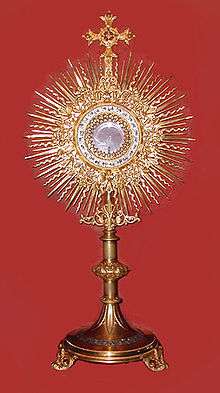
Christian meditation performed along with adoration of the Blessed Sacrament outside of Mass has been associated with a large number of Catholic writings and inspirations.
Apart from promoting the Eucharist, Saint Pierre Julien Eymard also performed meditations before the Blessed host and his writings were later published as a book: The Real Presence.[6] His contemporary, Saint Jean Vianney also performed Eucharistic meditations and books on his meditations have also been published.[7][8]
Saint Thérèse of Lisieux was devoted to Eucharistic meditation and on February 26, 1895 shortly before she died wrote from memory and without a rough draft her poetic masterpiece "To Live by Love" which she had composed during Eucharistic meditation. During her life, the poem was sent to various religious communities and was included in a notebook of her poems.[9][10]
Significant portions of the writings of the Venerable Concepcion Cabrera de Armida were reported as having been based on her adorations of the Blessed Sacrament.[11] Cabrera de Armida did not represent her writings as interior locutions or visions of Jesus and Mary but as her meditations and inspirations during Eucharistic adoration.
The Italian mystic Maria Valtorta's Eucharistic meditations titled Holy Hour of Jesus were recorded in her notebooks while she was bedridden for over 20 years and the Eucharist was brought to her.[71]
In her book Eucharist: true jewel of eucharistic spirituality Maria Candida of the Eucharist (who was beatified by Pope John Paul II) wrote about her own personal experiences and reflections on Eucharistic meditation.[12][13]
Perpetual adoration
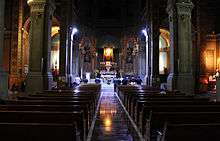
Perpetual adoration is the practice of the continuous exposition and adoration of the Eucharist, twenty four hours a day. Similar to the "Perpetual Rosary" in which the Rosary is recited uninterrupted by a changing group of people, this practice gained popularity among Roman Catholics in 19th century France, and has since spread to lay Catholics in parishes across the world.[14][72]
During perpetual adoration, a specific person performs adoration for a period of one hour or more, so there is always at least one person who performs adoration during each day and night. However, during Mass the Blessed Sacrament may be reposed and is then exposed again after Mass.[18] The only other time perpetual adoration is not performed is during the three days of Easter Triduum.[14]
Early traditions
Perpetual adoration of God by psalm and prayer has been a tradition among Christians since ancient times, e.g., in Eastern Christianity since the year 400 the Acoemetae monks kept up a divine service day and night and in Western Christianity the monks at the monastery of Agaunum performed perpetual prayers since its formation in 522 by King Sigismund.[42]

Mother Mechtilde of the Blessed Sacrament pioneered perpetual adoration of the Eucharist on request of Père Picotte.[73][74] Père Picotte was the confessor of Anne of Austria who asked him for a vow for the deliverance of France from war and the order was formed in response to that vow. A small house was bought on Rue Feron in Paris and a Benedictine convent, founded for this purpose, began perpetual adoration there on March 25, 1654, one or more nuns kneeling in front of the altar in adoration each hour of the day and night.[42] The simple Benedictine rules with which the nuns started were amended and formal approval for perpetual adoration was provided by the Camera Apostolica in Rome in 1705.[42]
Various Roman Catholic societies and orders were formed for the specific purpose of perpetual adoration prior to the 19th century, e.g., the Perpetual Adorers of the Blessed Sacrament (1659 in Marsaille), Congregation of the Sacred Hearts of Jesus and Mary and of the Perpetual Adoration (formed in 1768 in Paris), and the Religious of the Perpetual Adoration (1789, Switzerland).
By the beginning of the 19th century, in France, as well as elsewhere in Europe, strong currents in favor of the Eucharistic piety, devotions and adoration began to appear. Preachers such as Prosper Guéranger, Peter Julian Eymard and Jean Vianney very effective in renewing such devotions.[43][75]
The 19th century thus witnessed a rapid growth in perpetual adoration societies, and some existing orders (e.g., the Dominicans and the Poor Clares) [18] e.g., Sisters of the Perpetual Adoration (1845 in Brittany), Poor Clares of Perpetual Adoration (also in 1854), Religious of Perpetual Adoration (Brussels, 1857), Servants of the Most Blessed Sacrament (1858, Paris), Sisters of St. Francis of Perpetual Adoration (1863, Olpe, Germany), Holy Spirit Adoration Sisters (the Netherlands, 1896), etc. A number of perpetual adoration orders were also formed in the United States, e.g. Franciscan Sisters of Perpetual Adoration (1849 Wisconsin), and Benedictine Sisters of Perpetual Adoration (1874, Clyde, Missouri).
Since 1878, for 138 years and counting, the Franciscan Sisters of Perpetual Adoration have been praying nonstop longer than anyone in the United States. The practice began on August 1, 1878, at 11 a.m. and continues to this date.[76]
In Ireland, the Poor Clares of the Monastery of Saint Mary of the Angels of Perpetual Adoration, in Drumshanbo, County Leitrim, have the longest unbroken devotion to perpetual adoration, in Ireland, beginning on March 25, 1870 and continues on to this day 143 years later.
20th and 21st centuries
| Part of a series on |
| Devotions to Christ of the Catholic Church |
|---|
| Devotions |
| Prayers |
|
|
In the 20th century, the practice of perpetual adoration spread from monasteries and convents to Catholic parishes at large, and is now also performed by lay Catholics. The perpetual adoration chapel in Saint Peter's Basilica was inaugurated by Pope John Paul II in 1981 and a number of the major basilicas in Rome have also started perpetual adoration in the 20th century.[18][77]
Early in the 20th century, questions arose as to the suitability of perpetual adoration by lay Catholics. However, after various discussions, on June 2, 1991 (feast of Corpus Christi), the Pontifical Council for the Laity issued specific guidelines that permit perpetual adoration in parishes.[14] In order to establish a "perpetual adoration chapel" in a parish, the local priest must obtain permission from his Bishop by submitting a request along with the required information for the local "perpetual adoration association", its officers, etc.[14]
At the beginning of the 21st century, there were over 2,500 perpetual adoration chapels in Catholic parishes around the world. The United States (with about 70 million Catholics) had about 1,100 chapels, the Philippines (with about 80 million Catholics) 500, the Republic of Ireland (with about 4 million Catholics) about 150, South Korea (with about 4 million Catholics) had about 70.[15]
The world's largest Monstrance is in Chicago where a perpetual adoration chapel is under construction. This Sanctuary devoted to The Divine Mercy is being constructed adjacent to Church of St. Stanislaus Kostka, one of the city's Polish churches.[78]
See also
- Fermentum
- I Am: Eucharistic Meditations on the Gospel
- Reserved sacrament
- Showbread
- Seven Churches Visitation
References
- 1 2 An introductory dictionary of theology and religious studies by Orlando O. Espín, James B. Nickoloff 2007 ISBN 978-0-8146-5856-7 page 163
- 1 2 3 The Holy Eucharist by Francis A. n2001 ISBN 978-0-87973-978-2 page 110
- ↑ The seven sacraments by Anselm Grün, John Cumming 2003 ISBN 978-0-8264-6704-1 pages 82–83
- 1 2 Hardon 1997, p. 9.
- ↑ Encyclopedia of World Religions by Johannes P. Schadé 2006 ISBN 978-1-60136-000-7, see entry under Eucharistic adoration
- 1 2 The Real Presence: eucharistic meditations by Saint Pierre Julien Eymard, Sentinel Press, 1938 ASIN B00087ST7Q
- 1 2 The eucharistic meditations of the Curé d'Ars by Saint Jean Baptiste Marie Vianney Carmelite Publications (1961) ASIN B0007IVDMY
- 1 2 Eucharistic Meditations: Extracts from the Writings and Instructions of Saint John Vianney by H. Convert, Jean Baptiste Marie, Saint Vianney, and Mary Benvenuta 1998 ISBN 978-0-940147-03-4
- 1 2 Therese and Lisieux by Pierre Descouvemont, Helmuth Nils Loose, 1996 ISBN 978-0-8028-3836-0 page 245
- 1 2 Collected poems of St Thérèse of Lisieux by Saint Thérèse (de Lisieux), Alan Bancroft 2001 ISBN 978-0-85244-547-1 page 75
- 1 2 Concepción Cabrera de Armida. I Am: Eucharistic Meditations on the Gospel ISBN 978-0-8189-0890-3
- 1 2 Our Sunday Visitor's Catholic Almanac by Matthew Bunson 2008 ISBN 978-1-59276-441-9 page 255
- 1 2 Vatican Website
- 1 2 3 4 5 In the presence of our Lord by Benedict J. Groeschel, James Monti 1997 ISBN 978-0-87973-920-1 pages 167–171
- 1 2 Vatican website
- ↑ Vatican website
- 1 2 101 questions and answers on the Eucharist by Giles Dimock 2006 ISBN 978-0-8091-4365-8 pages 88–90
- 1 2 3 4 5 6 Peter Stravinskas, 1998, Our Sunday Visitor's Catholic Encyclopedia, OSV Press ISBN 978-0-87973-669-9 page 409
- 1 2 Theology at the eucharistic table by Jeremy Driscoll 2003 ISBN 978-0-85244-469-6 pages 237–244
- ↑ Sacred Congregation of Rites, INSTRUCTION ON EUCHARISTIC WORSHIP item 60
- 1 2 The Raccolta by Joseph P. Christopher 2003 ISBN 978-0-9706526-6-9 pages 107–108
- ↑ Peter Stravinskas, 1998, Our Sunday Visitor's Catholic Encyclopedia, OSV Press ISBN 978-0-87973-669-9 page 498
- ↑ Church and society: the Laurence J. McGinley lectures, 1988–2007 by Avery Dulles, Laurence J. McGinley 2008 ISBN 978-0-8232-2862-1 page 465
- ↑ Ecclesia de Eucharistia, Chapter 2, item 25
- ↑ 'Eucharistic Adoration';
- ↑ Heads of Agreement on the Lord's Supper by John Calvin';
- ↑ Hardon 1997, p. 3.
- ↑ 'Byzantine Daily Worship'; Archbishop Joseph Raya, Baron Jose de Vinck
- ↑ Franciscan Archives
- ↑ St Francis of Assisi: The Legend and the Life by Michael Robson 2002 ISBN 978-0-8264-6508-5 pages 83–84
- ↑ A Eucharistic Vision and the Spirituality of St Francis of Assisi by Mark Elvins 2007 ISBN 978-0-85244-663-8 pages 71–72
- ↑ Hardon 1997, p. 4.
- ↑ ["http://www.vatican.va/holy_father/paul_vi/encyclicals/documents/hf_p-vi_enc_03091965_mysterium_en.html Vatican website: Mysterium Fidei]
- ↑ Hardon 1997, p. 5.
- ↑ Hardon 1997.
- ↑
 McMahon, Joseph H. (1913). "Perpetual adoration". In Herbermann, Charles. Catholic Encyclopedia. New York: Robert Appleton Company.
McMahon, Joseph H. (1913). "Perpetual adoration". In Herbermann, Charles. Catholic Encyclopedia. New York: Robert Appleton Company. - 1 2 Hardon 1997, p. 8.
- ↑ John Paul II's book of saints by Matthew Bunson 1999 ISBN 978-0-87973-934-8 page 88
- ↑ Architecture in communion by Steven J. Schloeder 1998 ISBN 978-0-89870-631-4 page 98
- ↑ Franciscans at prayer by Timothy J. Johnson 2007 ISBN 978-90-04-15699-9 pages 444–445
- ↑ Italian Confraternities in the Sixteenth Century by Christopher F. Black 2003 ISBN 978-0-521-53113-9 page 99
- 1 2 3 4 A Catholic Dictionary by William E. Addis, Thomas Arnold 2004 ISBN 978-0-7661-9380-2 page 656
- 1 2 3 4 5 In the presence of our Lord by Benedict J. Groeschel, James Monti 1997 ISBN 978-0-87973-920-1 pages 132–134
- ↑ Hardon 1997, p. 11.
- ↑ Dorthy Scalan. The Holy Man of Tours. (1990) ISBN 978-0-89555-390-4
- ↑ 101 questions and answers on the Eucharist by Giles Dimock 2006 ISBN 978-0-8091-4365-8 page 125
- ↑ Joan Carroll Cruz, OCDS, Saintly Men of Modern Times. (2003) ISBN 978-1-931709-77-4
- ↑ Catholic encyclopedia
- 1 2 OSV's encyclopedia of Catholic history by Matthew Bunson 2004 ISBN 978-1-59276-026-8 page 334
- ↑ http://www.newadvent.org/cathen/05592a.htm
- ↑ The Catholicism Answer Book: The 300 Most Frequently Asked Questions by John Trigilio, Kenneth Brighenti 2007 ISBN 978-1-4022-0806-5 page 153
- ↑ "The Articles of Religion of the Methodist Church – The United Methodist Church". United Methodist Church. Retrieved 6 July 2016.
- ↑ The Thirty-Nine Articles Archived 25 June 2007 at WebCite
- ↑ "The Articles of Religion of the Methodist Church – The United Methodist Church". United Methodist Church. Retrieved 23 May 2015.
- ↑ The Thirty-Nine Articles Archived 25 June 2007 at WebCite
- ↑ Gibson, Edgar Charles Sumner (1908). The Thirty-nine Articles of the Church of England. Methuen & Company. p. 62.
- ↑ "Services". Church of the Ascension, Chicago. 2006. Archived from the original on 9 February 2006. Retrieved 23 May 2015.
- ↑ Corpus Christi article in Christian Cyclopedia
- ↑ The Sacrament of the Altar. A Book on the Lutheran Doctrine of the Lord's Supper by Tom G A Hardt
- ↑ Vatican website catechism item 1377
- ↑ Celebrating the Holy Eucharist by Francis Cardinal Arinze 2006 ISBN 978-1-58617-158-2 page 103
- ↑ The encyclopedia of saints by Rosemary Guiley 2001 ISBN 978-0-8160-4134-3 page 106
- ↑ A Drama of Reform by Benedict J. Groeschel 2005 ISBN 978-1-58617-114-8 page 30
- ↑ My Daily Eucharist II Joan Carter McHugh 1997 ISBN 978-0-9640417-5-2 page 14
- ↑ Ann Ball, 2003 Encyclopedia of Catholic Devotions and Practices ISBN 978-0-87973-910-2 page 11
- ↑ Vatican website: Dominicae Cenae
- ↑ Vatican website Ecclesia de Eucharistia
- ↑ Christ, Our Joy: The Theological Vision of Pope Benedict XVI by Joseph Murphy 2008 ISBN 978-1-58617-182-7 page 180
- ↑ God Is Near Us: The Eucharist, the Heart of Life by Joseph Ratzinger 2003 ISBN 978-0-89870-962-9 pages 88–91
- ↑ http://www.josemariaescriva.info/article/opus-dei-founder-spiritual-communion-a-prayer-that-went-round-the-world
- ↑ The Notebooks 1944 by Maria Valtorta and David G. Murray ISBN 978-88-7987-042-9
- ↑ Peter Stravinskas, 1998, Our Sunday Visitor's Catholic Encyclopedia, OSV Press ISBN 978-0-87973-669-9 page 776
- ↑ Catholic encyclopedia
- ↑ Catholic encyclopedia
- ↑ Alban Butler; Paul Burns (1998). Butler's Lives of the Saints: August. Burns & Oats. p. 16. ISBN 0860122573.
- ↑ History of Our Adoration
- ↑ Praying in the Presence of Our Lord: Players for Eucharistic Adoration by Benedict J. Groeschel 1999 ISBN 978-0-87973-586-9 page 57
- ↑ Catholic News Agency
Works cited
- Hardon, John A. (1997). The History of Eucharistic Adoration. CMJ Marian Publishers. ISBN 0-9648448-9-3.
External links
- The Reservation and Veneration of the Most Holy Eucharist from the Catholic Code of Canon law
- New Advent on Perpetual Adoration
- Location of Eucharistic Adoration sites
- Directory of Eucharistic Adoration Chapels
- Nocturnal Adoration Society
- Roger Oakland – The New Evangelization and the Coming Eucharistic Reign of Jesus
- The History of Eucharistic Adoration by Fr. John A. Hardon, S.J. in PDF format
- St. Martin of Tours Roman Catholic Church, Louisville, Kentucky's online perpetual adoration.
- Savior.org Online Eucharistic Adoration
- Eucharistic adoration and live adoration

